PennyLender's business goal is to create a software service that will allow any individual or business to loan and borrow money in a self-contained community-based network, irrespective of economic status, physical location, or age and without the interference of a central controlling Bank. In this framework people will be allowed to loan money to anyone in the network based on parameters that they control. In its simplest form, PennyLender is a Person-to-Person money network, but PennyLender does not differentiate between people and businesses. As such, PennyLender also allows individuals to loan money to local businesses in exchange for reduced prices in products and services. There are also other forms of functionality that PennyLender can assume that is explained in this document.
Todays banks have changed little over the last century in their core business model of aggregating client money into pools for subsequent lending to other participants. The traditional banking model is simple, however banks operate to maximize their profit at the expense of clients who receive less than maximum value for their money.
Credit Unions, a kind of non-profit banking construct, loans money out the same way conventional banks do, but because they put profits back into the business can offer better rates to their members than commercial banks.
Micro Banks are special types of banks that focus on small money lending. We wish to extend the Micro Bank concept by putting the lending and borrowing at the individual level, the least common denominator. This new model will allow participants to enjoy better rates than any of the above mentioned models.
The PennyLender framework will empower both people and businesses to control the rates by which money is loaned in society. This will improve not only the rates by which people can loan money against, but will also have the side effect of improving access to capital in all economic tiers in all countries and for any group who is currently discriminated against by Banks. This includes the poor and the under aged.
Our framework will allow local communities that are comprised of buyers, sellers, and their business associates to finance their business needs. For lenders we will enable the convenient identification and connection to borrowers who meet the lender's investment criteria, and with an easy transaction execution process. We will not be acting as banks in these transactions, (since we store no money), but more like market facilitators. Finance costs for the borrowers will be lowered and return on investment (ROI) will be increased for the lenders.
The drivers for borrowers are:
Lower cost of money (compared to banks and credit unions).
Wider set of lenders (community, customers, vendors).
Ease of use.
The drivers for lenders are:
Higher interest rates (compared to bank deposits).
Relatively low risk (lenders know borrowers as institutions in their community)
Ease of use.
As the PennyLender network grows, additional services will be added:
The ability for lenders to trade commercial paper (a bond market).
Underwriting and debt services.
Rating and ranking services.
Evaluation tools.
The ability for lenders to issue “Requests for Proposals” and announce their availability as lenders.
Partnerships for debt collection.
Mortgage investment.
Personal debt investment.
PennyLenders Standard framework has 4 operating modes, 2 of which we will implement. These 2 modes mandate that all involved parties are holders of bank accounts.
(a) Person to Person - Currently in development.
In the 1st mode, (labeled “a” in the diagram below), PennyLender is about enabling any individual to loan money directly to other individuals that meet their borrow criteria.
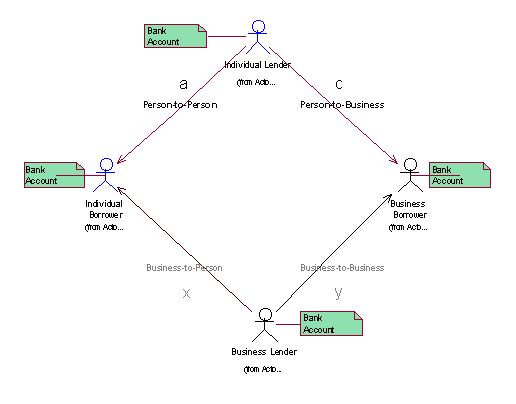
Standard Operating Modes Diagram
Value Proposition to Individuals:
Individuals can choose who they wish to conduct business with and on terms that they define and control.
Risk is mitigated by “risk ratings” associated with all individuals who want to borrow from the PennyLender network.
Individuals who would normally be discriminated by Banks and Credit Unions are allowed to participate in the PennyLender Network.
Individuals can “cluster” and form local networks within the PennyLender Network thus mitigating risk even further.
(c) Person to Business - Pending development.
PennyLender's 2ndmode, (labeled “c” in the above diagram), involves a direct relationship between a business and its clients. In this mode PennyLender is about enabling any business to grow by allowing its clients to loan money to the business in exchange for reduced rates in products and services provided by that business.
Value Proposition to Businesses:
Cash to invest in Businesses comes directly from clients who believe in the Business, basically its “shareholders” in the market place.
Businesses obtain a better "ownership" relationship with clients.
Businesses get a “loan rate” to invest in other areas of its business but can payback clients at effectively lower than the dollar value of the “loan rate” because they payback at their wholesale cost of products and/or services.
Value Proposition to Clients:
The client engages in a business investment that pays out better than any commercial bank or Credit Union would.
Client makes money and gets products/services that is suited for their lifestyle.
(x) Business to Person – No current development.
(y) Business to Business – No current development.
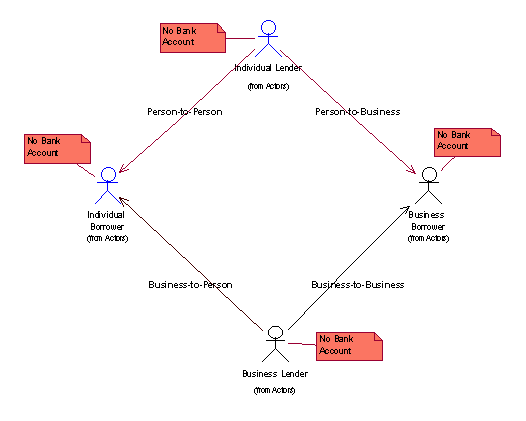
Non-Standard Operational Modes Diagram – No Bank Accounts
This diagram is identical to the previous except that Bank Accounts are non-existent in this topology. We intend to implement all 4 modes in this diagram.
Here is a combined mode diagram that merges the 2 previous diagrams (but drops the Business Lender relationships of the Standard diagram).
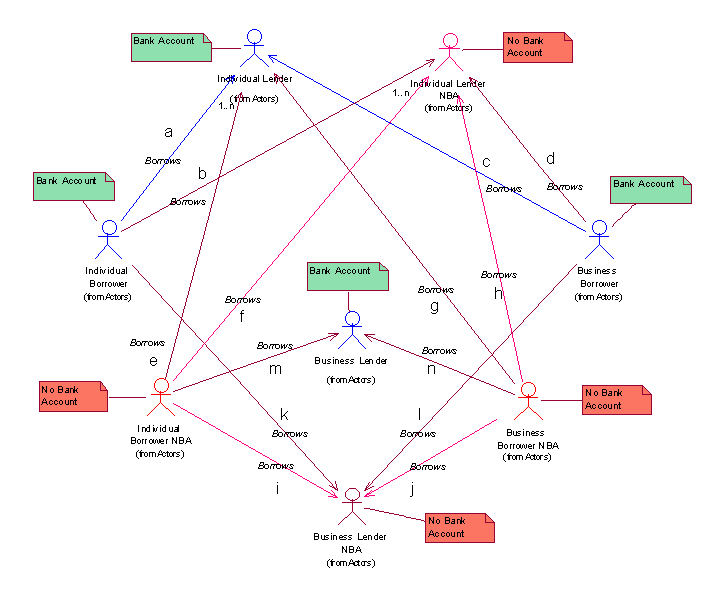
The combined modes network allows for greater participation in financial frameworks normally reserved for people and businesses with traditional bank accounts. This represents an immense opportunity for PennyLender to bring people and businesses without Bank Accounts into a "traditional" money network.
The lettered relationship links in the above diagram are itemized here:
(a) Currently in development. (Strongly coupled).
(b) Undetermined at this time. (Weakly coupled).
(c) Development pending. (Strongly coupled).
(d) Undetermined at this time. (Weakly coupled).
(e) Undetermined at this time. (Weakly coupled).
(f) PennyLender is currently researching ways to couple and deliver lending services to individuals and businesses that do not possess “traditional” bank accounts.
(No coupling).
(g) Undetermined at this time. (Weakly coupled).
(h) PennyLender is currently researching ways to couple and deliver lending services to
individuals and businesses that do not possess “traditional” bank accounts.
(No coupling).
(i) PennyLender is currently researching ways to couple and deliver lending services to individuals and businesses that do not possess “traditional” bank accounts.
(No coupling).
(j) PennyLender is currently researching ways to couple and deliver lending services to individuals and businesses that do not possess “traditional” bank accounts.
(No coupling).
(k) Undetermined at this time. (Weakly coupled).
(l) Undetermined at this time. (Weakly coupled).
(m) Undetermined at this time. (Weakly coupled).
(n) Undetermined at this time. (Weakly coupled).
The following 3 pages contains a flowchart depicting the processes involved in the Person-to-Person Lending Model. Following this are screen-shots taken from an test website that show actual Lend/Borrow records.
Person-to-Person Lending Activity Diagram
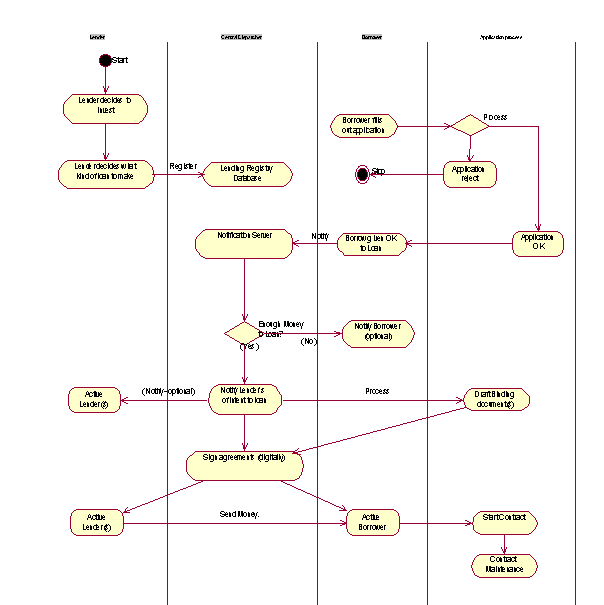
This
is a flowchart showing major pieces and decisions made when
PennyLender is operating in the Person-to-Person mode.

"Use Case" for Borrower fullfilling a Loan Contract.
Here are screen-shots taken from an internal test website.
In this example 2 lending records match a single Borrow record.
The top 5 records are Borrow records.
The bottom 3 records are Lending records.

The following 2 pages contains a flowchart depicting the processes involved in the Person-to-Business Lending Model with 2 examples showing potential relationships between a local business and a local client.
Person-to-Business Lending Activity Diagram
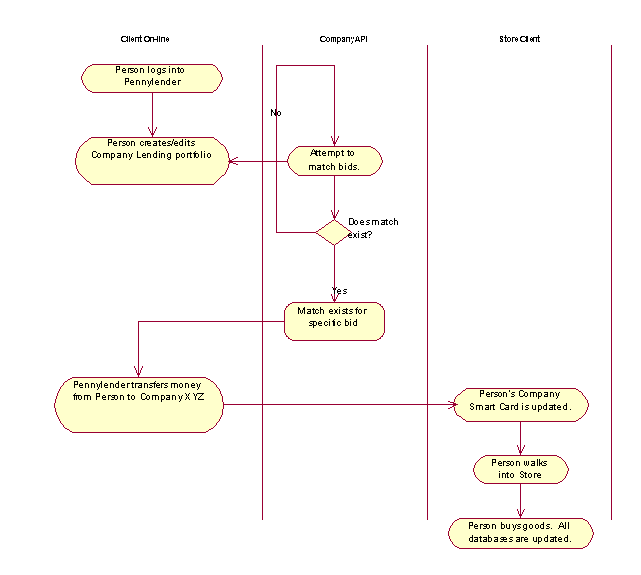
In
this mode a Client decides what businesses it wants to loan money
to. The businesses who respond to the lending criteria are obligated
to perform on this contract.
|
Example 1: Person-to-Business Lending. |
|
Step 1. Lender wants to invest in "Grain seeds" in Monterey, Mexico with the following terms
|
|
$10 Total Funds / per month 14% monthly return for 6 Months
|
|
Step 2. The grain distributor "La Tierra" near Monterey, Mexico agrees with following terms: 14% of 10 = $1.40/month shall be payable by the FREE purchase of various seeds or store goods, so that the client is allowed $1.40 off of goods each month for 6 months.
|
|
|
|
Example 2: Person-to-Business Lending. |
|
Step 1. Lender wants to invest in "Food Staples" in Mumbai, India with the following terms:
|
|
$20 Total Funds / per month 14% monthly return for 12 Months
|
|
Step 2. "Adil's Market" in Mumbai, India agrees with following terms: 14% of 20 = $2.80/month shall be payable by the FREE purchase of Store purchased items goods, so that the client is allowed $2.80 off of store goods each month for 12 months.
|
|
|
This appendix includes 3 diagrams:
1. Traditional Bank Lending Model: This depicts the traditional banking architecture.
2. Direct Lending Model: PennyLender's distributed approach to the re-processing of the traditional banking model that empowers the network participants.
3. UML Deployment View: This is a simple system component view for PennyLender's architecture.
Traditional Bank Lending Model
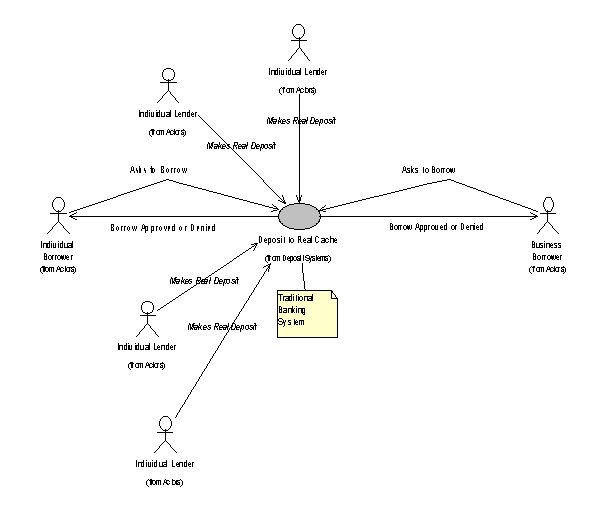
This diagram depicts a traditional Bank lending topology where multiple lenders contribute
money to a central pool for subsequent distribution. The distribution is controlled by a central authority.
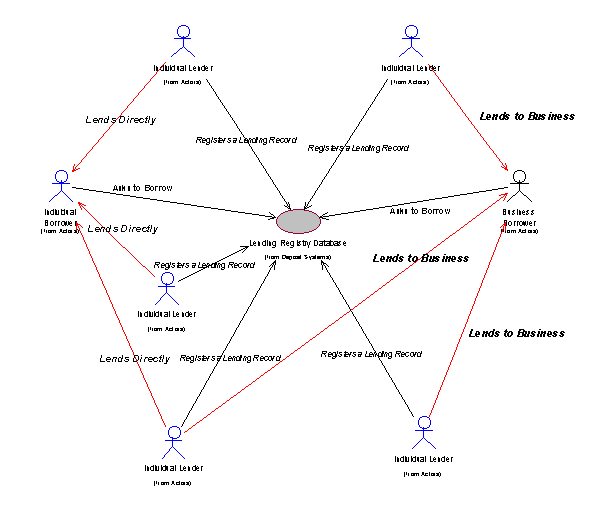
This diagram depicts PennyLenders approach to money lending where multiple lenders place virtual bids in a database for subsequent real money distribution through the original participants. The distribution is controlled by the network participants and not by any one entity. As depicted above, PennyLenders goal is to augment existing banking with an intelligent software framework controlled by the participants.
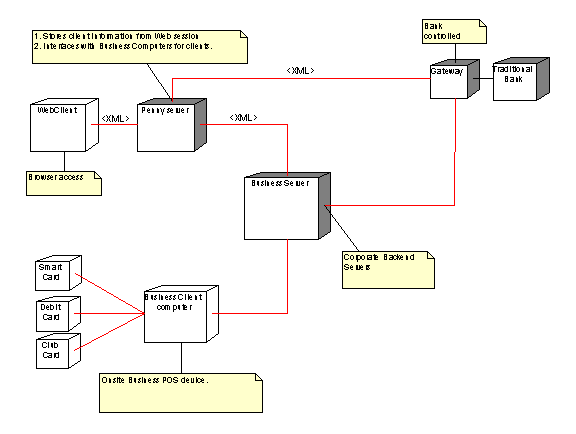
This diagram show major components for both the Person-to-Person mode and the Person-to-Business mode. PennyLender is currently implementing an XML Web Services-based framework for communication between the Business Servers and the PennyLender Servers.